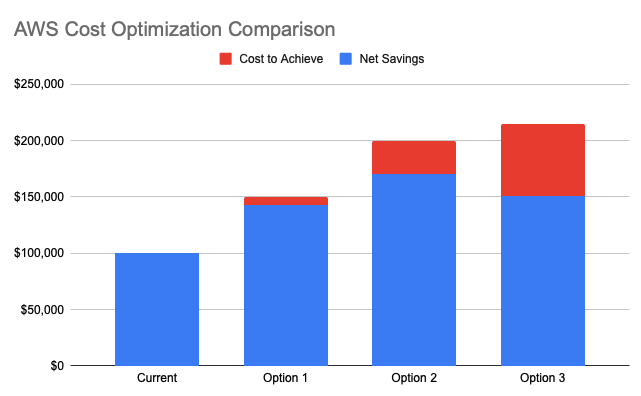Oscar Wilde is credited with saying, “Accountants know the cost of everything and the value of nothing.” When it comes to cloud financial management, I wouldn’t just single out the accountants. Even sophisticated FinOps, engineering and finance orgs struggle with the economic decision-making related to their AWS cost optimization efforts. The dollars left on the table are material. Every private equity buyer or activist investor understands the margin and/or investment pool trapped in the cloud profit and loss (P&L) line item of most technology-oriented enterprises.
So, why is cloud cost optimization pricing so difficult to navigate? For one, software buyers are trained to focus on cost because, in many cases, it is the only objective metric they can associate with a given SaaS service. But the value they’re getting out of their software is highly subjective. What is Carta, Gmail or Hubspot worth to Company A vs. Company B? If buyers aren’t seeing value, they’ll churn or renegotiate contracts, or even bring on an IT procurement-as-a-service software to manage it for them.
Let’s look at some examples of how SaaS companies try to define value with pricing, and how cloud cost optimization customers can derive actual value (in dollars and cents) from their vendors.
Software pricing psychology vs. actual value
SaaS vendors use all sorts of pricing psychology to manipulate how customers perceive value. Maybe you’ve seen some of these conventions at work.
- Anchor pricing: People tend to have a psychological bias toward the first piece of information they see, and that includes price. You’ll see anchor pricing often in tiered pricing for SaaS companies. Given three tiers, we tend to anchor on the highest price provided in the first tier, so the other two tiers present a higher perceived value based on the “discount.” Using this psychological model, most people will choose the middle tier.
- Freemium pricing: Many SaaS companies offer freemium pricing, or a free tier meant to entice customers enough to upgrade to a paid version. With freemium pricing, many companies make the mistake of offering too much for free, or making the transition to a paid plan far too difficult or costly to achieve. In this case, it’s critical to grow incrementally.
- Decoy pricing: There are three options, but one is clearly inferior to the other two. Given these options, the inferior one is obviously ruled out. The other two options become more attractive to buyers by default. Decoy pricing happens most often when a company has a clear, preferred option to market to buyers.
SaaS companies don’t need these tricks if the service can objectively be tied to outcomes, and customers can be confident that the service actually delivered that outcome. With cloud cost optimization, this shouldn’t be hard. Using AWS’ APIs and Cost and Usage Report, teams have access to the costs and benefits of discount instruments like Reserved Instances and Savings Plans in their system of record. It’s up to cost optimization companies to be transparent about how they tie pricing directly to optimization outcomes.
How pricing works with cloud cost optimization
Some cloud cost optimization companies employ a savings share or gain sharing pricing model. Gainsharing involves pricing a product based on the “gains” or business benefits it provides to the customer. That means a vendor would only make money if you saved money on your cloud bill.
Since gainsharing is different from most pricing models, people tend to misalign software pricing and value. For example, you could pay your brother-in-law’s money management firm $1,000 a year to manage your investments, vs. paying Sequoia 2 percent of total and 20 percent of returns. You may get hung up on the fact that your brother-in-law only charges $1,000, even though his returns are far less than what you could achieve with Sequoia.
Let’s model what gainsharing might look like in the cloud cost optimization world.
AWS cost optimization pricing based on net savings
When it comes to achieving your AWS cost optimization goals, you have a few different options. Some teams choose a DIY approach, where they manage their own discount instruments on a regular basis. If you use this approach, how much time do your engineers spend optimizing cloud costs?
Others select a cloud cost optimization tool to make the process simpler, or in some cases, even manage the process for them entirely. For example, ProsperOps autonomously optimizes your cloud costs by algorithmically managing your RIs and Savings Plans—similar to how a robo-advisor might manage your financial investments.
The chart below represents a theoretical example of the cost vs. savings associated with each approach. Net savings represents the savings minus the cost of each tool.
| Metric | Current (DIY) | Option 1 | Option 2 | Option 3 |
| Cost | — | $7,500 | $30,000 | $64,500 |
| Savings | $10,000 | $150,000 | $200,000 | $215,000 |
| Net Savings | $100,000* | $142,500 | $170,000 | $150,500 |
*Engineering resources aren’t free; actual net savings may vary
Presented with these options and this information, let’s deconstruct some common pricing mistakes businesses can make when evaluating cloud cost optimization options.
- Price Sensitivity: Some may select the lowest-cost choice, Option 1, in an effort to save money on the price of software. However, net savings end up being far lower than if they went with the higher priced Option 2, and even slightly lower than Option 3. What’s more important: software costs or net savings?
- Ignoring Savings vs. Cost: Some may make the mistake of choosing Option 3, because they’re attracted to the highest top-line savings amount. However, the higher cost of the cost optimization software cannibalizes any gains in net savings, which should be the highest indicator of value.
- DIY with Opportunity Cost: Some may decide to stay the course, investing time and resources to save $100,000 themselves. While this approach is better than doing nothing, it takes engineering resources away from other high-value activities. And, as you can see in the chart above, these teams may be ignoring the added net savings they could achieve by selecting a turnkey cloud cost optimization tool.
Instead, the clear economic winner in the graph below is Option 2 (modeled based on ProsperOps). While there may be cheaper AWS cost optimization solutions (Option 1) and human-supported solutions (Option 3), ProsperOps delivers more net savings ($170K) by autonomously optimizing your AWS cloud costs to save you time and maximize your Effective Savings Rate.

How ProsperOps thinks about pricing
As you can see in the model above, ProsperOps meets the hurdle of pricing for cost optimization tools, based on objective value. Our system is doing the work and providing the outcome of higher net savings (as demonstrated above).
Using ProsperOps, customers can see the savings returned to their AWS budget and definitively know those savings came from our platform’s optimizations. What’s more, they can audit those outcomes by referencing the AWS Cost Explorer as a system of record.

Before you sign up for ProsperOps, we benchmark your current savings performance, or Effective Savings Rate (ESR). ESR is a value-oriented, objective FinOps metric that represents the discount you’re receiving off AWS on-demand rates for cloud compute services. Our platform helps you maximize your ESR by automatically managing and optimizing a portfolio of AWS Reserved Instances and Savings Plans on your behalf.
Lifetime Incremental Savings
To help customers track their total net savings as a result of using our automated service (the blue bars in the chart above) we introduced a metric called Lifetime Incremental Savings (LIS). LIS represents the delta between what you would have saved, based on your benchmark ESR, and what you saved with ProsperOps, net of our charge. In other words, Lifetime Incremental Savings shows you the total net savings returned to your cloud budget—above and beyond what you could have achieved on your own—expressed in dollars and cents.
Unlike traditional SaaS pricing where value is subjective, pricing for cloud cost optimization solutions can and should make their value clear. ESR is an objective measurement with a crystal clear outcome: net savings. If you’re considering purchasing a cloud cost optimization tool, your first question should be: Which of these options returns the highest net savings?
Want to find out how ProsperOps can drive better cloud cost optimization outcomes for you? Benchmark your ESR for free with an AWS savings analysis.





